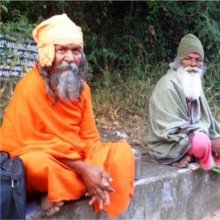Siddhakshetra, Siddhakṣetra, Siddha-kshetra: 9 definitions
Introduction:
Siddhakshetra means something in Hinduism, Sanskrit, Jainism, Prakrit, the history of ancient India. If you want to know the exact meaning, history, etymology or English translation of this term then check out the descriptions on this page. Add your comment or reference to a book if you want to contribute to this summary article.
The Sanskrit term Siddhakṣetra can be transliterated into English as Siddhaksetra or Siddhakshetra, using the IAST transliteration scheme (?).
Images (photo gallery)
In Hinduism
Purana and Itihasa (epic history)
Source: Cologne Digital Sanskrit Dictionaries: The Purana Index1a) Siddhakṣetra (सिद्धक्षेत्र).—On the banks of the Ganges.*
- * Matsya-purāṇa 110. 12.
1b) In the Himālayas;1 where Yogins go with their very bodies or Kāyārohaṇam.2

The Purana (पुराण, purāṇas) refers to Sanskrit literature preserving ancient India’s vast cultural history, including historical legends, religious ceremonies, various arts and sciences. The eighteen mahapuranas total over 400,000 shlokas (metrical couplets) and date to at least several centuries BCE.
In Jainism
General definition (in Jainism)
Source: Google Books: Jaina IconographySiddhakṣetra (सिद्धक्षेत्र).—One of the five heavens of the upper world (ūrdhvaloka);—Twelve yojanas above Sarvarthasiddhi (the fifth Anuttara), at the summit of the universe, is the Siddha-kṣetra, the land of liberated souls, in the world called Īṣatprāgbhāra. In its middle, radiant like silver is the Siddha-kṣetra, shaped like a parasol or canopy, tapering up towards the top. Here the Siddhas live “in the Blissful possession of their infinite quarternary”
Source: Shodhganga: A cultural study on the jain western Indian illustrated manuscriptsSiddhakṣetra (सिद्धक्षेत्र).—The siddha-kṣetra or mokṣa is situated at the symbolic forehead of the creations where all the jīvās having attained nirvana reside in a state of peace and eternal happiness. Outside the symbolic figure of this creation nothing but aloka or ākāśa (sky) exists

Jainism is an Indian religion of Dharma whose doctrine revolves around harmlessness (ahimsa) towards every living being. The two major branches (Digambara and Svetambara) of Jainism stimulate self-control (or, shramana, ‘self-reliance’) and spiritual development through a path of peace for the soul to progess to the ultimate goal.
India history and geography
Source: DSpace at Pondicherry: Siddha Cult in Tamilnadu (historical)Celebrated Siddha Kṣetras of Tamilnādu.—From very simply marked sacred tree, a snake hill, a smeared stone, a samādhi shrine, a picture of a favored deity, to enlarged temples, there are thousands of sacred centres found all over the Tamilnādu. Of them, the places dedicated to Siddhas and their samādhis attract millions of devotees.
Gradually many of these Siddha shrines in some places are worshipped as clan and folk deities. Then these Siddha shrines or samādhis become sanskritisized. Some of them become more prosperous and attain more popularity and importance due to increased status in which the brahmanical mode of worship is taking place.

The history of India traces the identification of countries, villages, towns and other regions of India, as well as mythology, zoology, royal dynasties, rulers, tribes, local festivities and traditions and regional languages. Ancient India enjoyed religious freedom and encourages the path of Dharma, a concept common to Buddhism, Hinduism, and Jainism.
Languages of India and abroad
Sanskrit dictionary
Source: DDSA: The practical Sanskrit-English dictionarySiddhakṣetra (सिद्धक्षेत्र).—the abode of sages or Siddhas.
Derivable forms: siddhakṣetram (सिद्धक्षेत्रम्).
Siddhakṣetra is a Sanskrit compound consisting of the terms siddha and kṣetra (क्षेत्र).
Source: Cologne Digital Sanskrit Dictionaries: Cappeller Sanskrit-English DictionarySiddhakṣetra (सिद्धक्षेत्र).—[neuter] the field of the blessed, [Name] of a place.
Source: Cologne Digital Sanskrit Dictionaries: Monier-Williams Sanskrit-English DictionarySiddhakṣetra (सिद्धक्षेत्र):—[=siddha-kṣetra] [from siddha > sidh] n. ‘land of the Blest’, a region inhabited by the Siddhas (also as Name of various sacred regions), [Mahābhārata; Kathāsaritsāgara; Purāṇa]
[Sanskrit to German]
Sanskrit, also spelled संस्कृतम् (saṃskṛtam), is an ancient language of India commonly seen as the grandmother of the Indo-European language family (even English!). Closely allied with Prakrit and Pali, Sanskrit is more exhaustive in both grammar and terms and has the most extensive collection of literature in the world, greatly surpassing its sister-languages Greek and Latin.
Kannada-English dictionary
Source: Alar: Kannada-English corpusSiddhakṣētra (ಸಿದ್ಧಕ್ಷೇತ್ರ):—[noun] a place, region, where semi-divine beings, persons endowed with supernatural faculties, inspired sages seers, etc. are living or supposed to be present (either in physical or spiritual form).
Kannada is a Dravidian language (as opposed to the Indo-European language family) mainly spoken in the southwestern region of India.
See also (Relevant definitions)
Partial matches: Kshetra, Siddha.
Starts with: Siddhakshetraparvata.
Full-text: Mangitungi, Siddhakshetraparvata, Siddhasamakhya, Siddhadhaman, Siddhayatana, Siddhikshetra, Shikhandi, Shikhandin, Guhavasi, Pancashukla, Urdhvaloka, Kuberatunga, Mahalaya, Shrisailam, Varanasi, Kshetra, Mathura.
Relevant text
Search found 7 books and stories containing Siddhakshetra, Siddha-ksetra, Siddha-kṣetra, Siddha-kṣētra, Siddha-kshetra, Siddhakṣetra, Siddhaksetra, Siddhakṣētra; (plurals include: Siddhakshetras, ksetras, kṣetras, kṣētras, kshetras, Siddhakṣetras, Siddhaksetras, Siddhakṣētras). You can also click to the full overview containing English textual excerpts. Below are direct links for the most relevant articles:
The Skanda Purana (by G. V. Tagare)
Chapter 1 - The Greatness of Mahākālavana < [Section 1 - Avantīkṣetra-māhātmya]
Chapter 186 - The Greatness of Kanakhaleśvara (kanakhala-īśvara-tīrtha) < [Section 3 - Revā-khaṇḍa]
Chapter 52 - Greatness of Rudrakoṭi < [Section 1 - Tīrtha-māhātmya]
The Padma Purana (by N.A. Deshpande)
Chapter 159 - Koṭaratīrtha < [Section 6 - Uttara-Khaṇḍa (Concluding Section)]
Chapter 1 - The Contents of the Section in Brief < [Section 6 - Uttara-Khaṇḍa (Concluding Section)]
Jainism and Patanjali Yoga (Comparative Study) (by Deepak bagadia)
Part 3.4 - Nine Elements (9): Moksa (Liberation) < [Chapter 3 - Jain Philosophy and Practice]
Lakulisha-Pashupata (Philosophy and Practice) (by Geetika Kaw Kher)
Overall Structure and Methodological considerations < [Introduction]
History of Lakulisa-Pasupata order < [Chapter 1 - The Historical Context]
Kathasaritsagara (the Ocean of Story) (by Somadeva)
Chapter CVII < [Book XIV - Pañca]
The Linga Purana (by J. L. Shastri)
Chapter 24 - Incarnations of Śiva < [Section 1 - Uttarabhāga]
